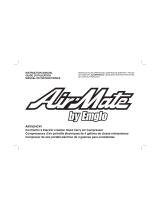WARNING: Risk of unsafe operation. Risk from noise. Air tanks
contain high pressure air. Keep face and other body parts away from
outlet of drain. Use eye protection [ANSI Z87.1 (CAN/CSA Z94.3)]
when draining as debris can be kicked up into face.
WARNING: Risk from noise. Use ear protection [ANSI S12.6
(S3.19)] as air flow noise is loud when draining.
NOTE: All compressed air systems generate condensate that
accumulates in any drain point (e.g. tanks, filter, aftercoolers, dryers).
This condensate contains lubricating oil and/or substances which
may be regulated and must be disposed of in accordance with local,
state, and federal laws and regulations.
1. Ensure Auto/Off switch is in the OFF position.
2. Place a suitable container under the drain valve (H) to catch
discharge.
3. Grasp lever on drain valve.
4. Slowly rotate lever to gradually bleed air from air tank.
WARNING: Risk of bursting. Drain air tank daily. Water will
condense in air tank. If not drained, water will corrode and weaken
the air tank causing a risk of air tank rupture.
NOTICE: Risk of property damage. Drain water from air tank may
contain oil and rust, which can cause stains.
5. When air tank pressure gauge reads 10 psi, rotate valve to the
fully open position.
6. Close drain valve when finished.
WARNING: Hot surfaces. Risk of burn. Outlet tube, pump head,
and surrounding parts are very hot, do not touch. Allow compressor
to cool prior to servicing.
1. Ensure Auto/Off switch (A) is in the OFF Position.
2. Allow unit to cool.
3. Remove filter cover (J) from base.
4. Remove element from filter base.
J
5. Place new element back in filter
base. Purchase replacement parts
from your local dealer or authorized
service center. Always use identical
replacement parts.
6. Snap filter cover to filter base.
NOTICE: Risk of unsafe operation. Do not operate without air inlet
filter
Recommended accessories for use with your tool are available
for purchase from your local dealer or authorized service center.
If you need assistance in locating any accessory for your tool,
please contact D
e
WALT Industrial Tool Co., 701 East Joppa Road,
Baltimore, MD 21286, call 1-800-4-D
e
WALT (1-800-433-9258) or visit
our website www.dewalt.com.
WARNING: The use of any other accessory not recommended for
use with this tool could be hazardous. Use only accessories rated
equal to or higher than the rating of the air compressor.
Please have the following information available for all service calls:
Model Number ____________ Serial Number _________________
Date and Place of Purchase ______________________________
To assure product SAFETY and RELIABILITY, repairs, maintenance
andadjustmentshouldbeperformedbyaD
e
WALT factory service
center, a D
e
WALT authorized service center or other qualified
service personnel. Always use identical replacement parts.




















